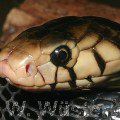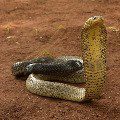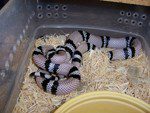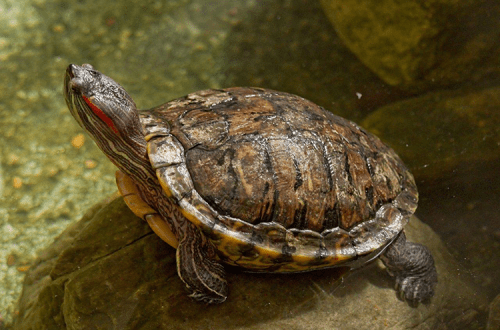
Cobra black and white
The black and white cobra (Naja melanoleuca) is undeservedly neglected in comparison with its famous relatives – the king and Egyptian cobras. But it is considered the largest among African snakes. And at the same time it is incredibly beautiful – with smooth shiny scales and contrasting black and white coloring. The black and white cobra is also commonly known as the forest snake because it lives in dense African forests, often climbing trees. And sometimes this snake can be found on the territory of fruit plantations. So a person should be more careful, because the black and white cobra is no less dangerous than its other relatives. But she, like all cobras, tends to warn of danger rather than bite immediately, so that people always have the opportunity to avoid her bite.
Contents
Classification
Kingdom: Animals
Type: Chord
Subtype: Vertebrates
Class: Reptiles
Order: Scaly
Suborder: Snakes
Family: Asps
Genus: Real cobras
Species: Black and white cobra, forest cobra, Naja melanoleuca
Appearance
 The standard size of a black and white cobra is 2 meters, but larger individuals are also found in nature. This snake has a slender and not overweight body, unlike some other types of cobras. Its head and anterior-abdominal part are grayish-brown with small black specks, but the back is completely black with a metallic sheen. The uniqueness of this species lies precisely in its color. This is the only cobra in which the back of the body and tail are much darker than the front. The coloration of young black and white cobras is somewhat different from adults. The young growth is decorated with narrow white stripes. The metallic sheen of the scales, perhaps, is achieved by its special, as if lacquered, smoothness. And black and white cobras are real centenarians. One of them lived in captivity for 29 years. Previously, only anacondas were able to achieve this record.
The standard size of a black and white cobra is 2 meters, but larger individuals are also found in nature. This snake has a slender and not overweight body, unlike some other types of cobras. Its head and anterior-abdominal part are grayish-brown with small black specks, but the back is completely black with a metallic sheen. The uniqueness of this species lies precisely in its color. This is the only cobra in which the back of the body and tail are much darker than the front. The coloration of young black and white cobras is somewhat different from adults. The young growth is decorated with narrow white stripes. The metallic sheen of the scales, perhaps, is achieved by its special, as if lacquered, smoothness. And black and white cobras are real centenarians. One of them lived in captivity for 29 years. Previously, only anacondas were able to achieve this record.
The body structure of a black and white cobra is similar to other members of the genus. True, her hood is quite small. However, muscle efforts and rib movements are also applied to inflate it. The poisonous teeth of the black and white cobra are similar to all aspids. Inside, they have a venom-conducting canal, are located on the upper jaw and are slightly bent back. The immobility of the teeth obliges the cobra to open its mouth wide when biting and sometimes make several chewing movements with its jaws, in contrast to lightning-biting vipers. However, the behavior of cobras is much nobler than that of vipers. They will not bite unnecessarily, but will only do so in case of extreme danger.
Distribution and habitation
You can meet a black and white cobra mainly in the central part of the African mainland to the Ngola, in countries such as Zimbabwe, Southern Mozambique, Western Ethiopia, Eastern Senegal, southern Somalia, Sierra Leone. In other areas, it is quite rare. The tropical and subtropical zones are quite favorable for snake life. In terms of biotope selection and nutrition, it is quite unpretentious and quickly adapts to changing conditions. Therefore, human economic activity does not have a particular impact on the distribution of black and white cobras. For example, it is known that when forests are destroyed, these snakes get along well in cut down areas. So the black-and-white cobra sometimes lives both in the shrub savannas and in the forest lowlands. She does not care what kind of vegetation surrounds her – tall trees or undersized shrub groves. Forest cobras of a darker color prefer the tropical thickets of Sierra Leone, Kenya, Zaire, the northern borders of Angola, forested mountains in Sudan, Kenya, and Ethiopia. Snakes whose color is closer to brown settled in Somalia, on the coastal plains of Kenya and Tanzania, in Malawi, in the north and east of the coast of South Africa, Mozambique, Northern Zambia, Zaire and in the eastern highlands of Zimbabwe. Striped cobras are found in the West African savannas of the Gambia and Nigeria. Thus, all possible subspecies of black and white cobras prefer different biotopes – from savannahs and grasslands, to dense forests and forested mountain slopes, depending on the conditions of the area. They can climb mountains up to 2800 meters above sea level.
Behavior and lifestyle
 The black and white cobra is an excellent climber. She easily overcomes hills and climbs trees. Often this snake is located near water. Zoologists consider it a rather aggressive species, since the black-and-white cobra, unlike some of its relatives, prefers to meet danger face to face, rather than retreat or hide in cover. It is active both during the day and at night and, among other things, is considered one of the most intelligent snake species. In captivity, the black-and-white cobra manifests itself as a rather nervous snake. She vigilantly monitors everything that is happening around and it is difficult to get used to the presence of people. However, when she gets used to it, she can begin to recognize the owner who feeds her. The black and white cobra lends itself well to training and education. She gradually gets used to the regimen established by the person and already knows at what time her cage will be opened. In general, this snake is highly trainable.
The black and white cobra is an excellent climber. She easily overcomes hills and climbs trees. Often this snake is located near water. Zoologists consider it a rather aggressive species, since the black-and-white cobra, unlike some of its relatives, prefers to meet danger face to face, rather than retreat or hide in cover. It is active both during the day and at night and, among other things, is considered one of the most intelligent snake species. In captivity, the black-and-white cobra manifests itself as a rather nervous snake. She vigilantly monitors everything that is happening around and it is difficult to get used to the presence of people. However, when she gets used to it, she can begin to recognize the owner who feeds her. The black and white cobra lends itself well to training and education. She gradually gets used to the regimen established by the person and already knows at what time her cage will be opened. In general, this snake is highly trainable.
In terms of aggression, the black and white cobra is somewhat different from other cobras. She will not think long to bite, and will not intimidate the enemy for a long time. Of course, short warnings are possible, but otherwise this snake shows great courage. At the same time, her bite is practically painless, and the injected amount of poison can kill a creature weighing up to a whole ton. At the same time, for the cobras themselves, the poison of their relatives is absolutely not dangerous, snakes have a special protective mechanism against it, on the basis of the study of which an antidote for people was also developed.
In natural habits, the black and white cobra is similar to the rest of the representatives of the genus of real cobras. She also inflates her hood, also arranges false attacks and is just as unpretentious in food. And of course, the size of the black and white cobra oblige to provide her with a suitable terrarium. True, this is somewhat more complicated than in the case of, for example, the Egyptian cobra, since the black-and-white cobra, in addition to free spaces, also needs vegetation.
Food
The main food of black and white cobras is small mammals, lizards, frogs and birds living on the ground. She is also prone to cannibalism. There are cases when an adult snake without a twinge of conscience ate the offspring of another black and white cobra. It is recommended to feed her in captivity in a variety of ways. Good for feeding rodents. A meat diet is also possible, but the cobra must be accustomed to it, since it is still a hunter by nature and is used to considering live prey as food.
Reproduction
In the breeding of black and white cobras, the most interesting is the mating season, when two males arrange demonstration fights for the favor of the female. So, black and white cobras have a place to be not just paired, but even group “snake dances”. True, they do not end with a disastrous result, since the victorious male favorably lets the loser go about their business. Black and white cobras lay eggs, the number of which can vary from 15 to 25 pieces. They make a nest on the ground and guard it during the entire incubation period. Young growth is born especially contrastingly colored and poisonous from the first day of life.
Sources of
http://www.zmeuga.ru/
Home
http://www.razedahell.com





